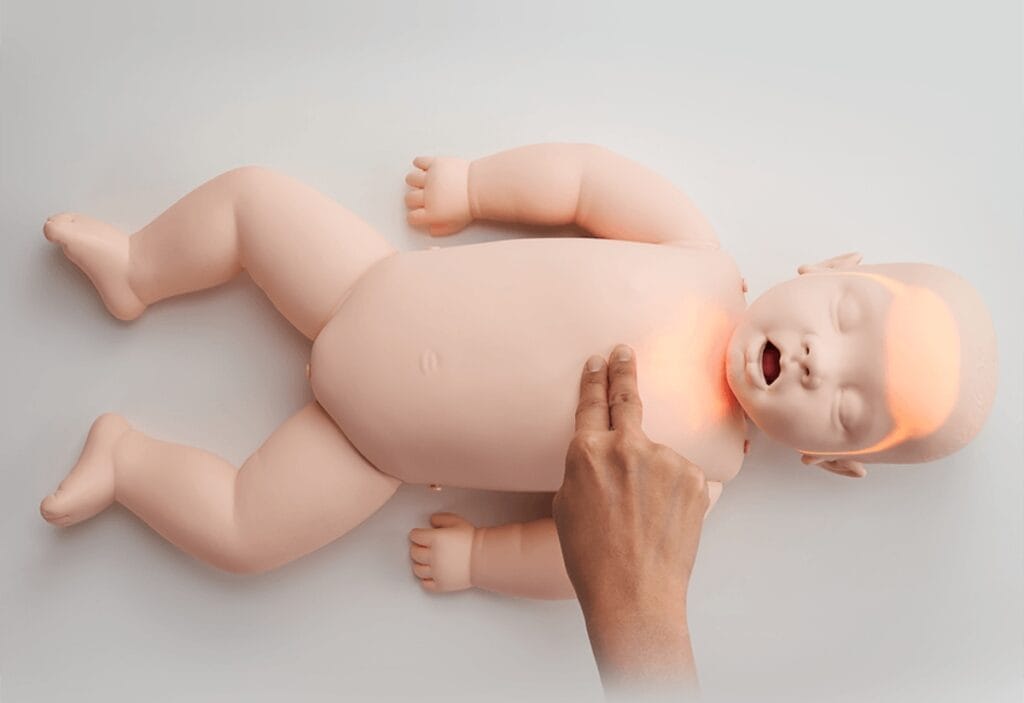Infant cardiac arrest is rare, but when it happens, it is critical that responders are able to perform high-quality infant CPR. Despite its importance, studies show that infant CPR is often performed poorly, and skills can fade quickly after training. This brings the need for more effective, evidence-based training methods that improve both performance and retention.
By utilising modern teaching strategies, realistic equipment, and objective feedback, CPR instructors can improve the way that responders learn and practice CPR on infants, resulting in better chances of survival.
Low-Dose, High-Frequency Training
Traditional CPR training often relies on annual certification. However, research shows that skills – especially infant CPR – can fade within six months. Guidelines from the Resuscitation Council UK (RCUK) recommend more frequent, spaced-out sessions, sometimes as often as every few months, to help prevent decline.
As a result, low-dose, high-frequency training is becoming the preferred approach. Short, regular refreshers help to embed muscle memory and improve confidence under pressure.
The shift to competency-based training
This represents a move away from input-based learning, which was more course-oriented. Leaners are now expected to demonstrate real proficiency using measurable criteria. This might include hitting specific targets for compression depth and ventilation on feedback-equipped manikins. One study found that 96% of participants who trained to a set standard reached infant CPR competency, with most of those skills retained over the following months.
Tools that offer real-time feedback are also key. Devices that track compression depth, ventilation, and rate help trainees correct mistakes instantly. This leads to better skill development and retention.
Realism is a Crucial Factor
To optimise resuscitation training outcomes, it is not enough to teach the steps – the context and environment of infant emergencies must also be simulated. Simulation-based training has become a cornerstone of modern CPR education, as it bridges the gap between classroom learning and real-life application. The Resuscitation Council UK explicitly recommends the use of simulation in resuscitation education, noting that it facilitates contextualised learning and integrates both technical and non-technical skills.
This means creating scenarios that mimic real infant resuscitation
For instance, trainees might be presented with a lifelike scenario of an unresponsive baby, requiring them to not only perform infant CPR skills but also to communicate with team members, manage panicked family members, and make quick decisions under pressure. By immersing students in realistic paediatric emergency scenarios, instructors help them develop situational awareness, communication, and teamwork skills alongside the hands-on CPR techniques. These soft skills of coordination and calm leadership can significantly impact the outcome of infant resuscitation.
Equally important is the realism of the simulation tools themselves
High-quality infant CPR manikins and training aids add authenticity to the scenario, making the learner’s experience more true-to-life. A manikin that approximates an infant’s anatomy and responses can teach nuances that static models cannot. Realistic features such as an anatomically correct airway, chest movement with ventilation, and palpable pulses all contribute to a richer learning experience. This level of realism boosts confidence: when faced with an actual infant collapse, providers who have “been there before” in simulation are more likely to remain composed and apply their training effectively.
A critical aspect of simulation-based training is debriefing and feedback
Running an infant resuscitation scenario is only half the exercise; the learning is cemented during the guided reflection afterwards. Instructors facilitate a debrief to discuss what went well and what could be improved, allowing trainees to learn from mistakes in a safe environment. Research in resuscitation education indicates that profound learning occurs during these debriefing sessions. Participants can reflect on their technical performance and on team dynamics and then strategise how to improve in future simulations.
The use of data-driven debriefing is particularly valuable – for instance, reviewing the objective metrics from a feedback manikin alongside the team’s communication timeline. Such comprehensive debriefs turn each simulation into a powerful learning opportunity, reinforcing correct behaviours and remedying issues before they can impact real patients.
Looking to Enhance Outcomes with Infant CPR Manikins?
The Brayden Baby is one of the most advanced tools available for infant CPR training. Developed with input from paediatric experts, it’s the first manikin to offer real-time visual feedback on blood flow during CPR.
LED lights in the chest and head simulate blood flow from the heart to the brain, illuminating only when CPR is performed to target standards. These lights provide immediate feedback on:
- Ventilation volume – Lights activate when breaths are delivered correctly.
- Compression depth – Chest LEDs glow when compressions are deep enough (around 4 cm).
- Compression rate – Carotid pulse lights flash when the ideal rhythm is met.
- Recoil and hand placement – A forehead light confirms the proper technique.
This instant feedback helps learners self-correct in real-time. If compressions are too shallow or hand position is wrong, the lights don’t activate, giving clear, intuitive signals to adjust technique.
The Brayden Baby Pro version connects to Brayden Online for even deeper insights. It tracks and records key metrics so that performance can be reviewed after each session. This data-driven approach supports more accurate assessments and helps identify consistent problem areas, like compression fatigue over time.
To find out more about the Brayden Baby, get in touch with us today.
FAQs
How often should infant CPR training be refreshed?
CPR skills can fade within months. Short, regular refreshers every 2 to 12 months are recommended for better retention.
Why is simulation important in infant CPR training?
Realistic scenarios help learners practise under pressure, build confidence, and develop both technical and non-technical skills.
What makes the Brayden Baby manikin different?
It provides real-time visual feedback on key CPR metrics like compression depth and ventilation volume, helping learners self-correct on the spot.
Is it enough to just pass a CPR course?
No. Competency-based training ensures learners meet objective performance standards, not just complete a course.
How can instructors assess infant CPR performance?
Using checklists, scenario testing, and feedback manikins ensures consistent, measurable assessments of CPR technique and readiness.
Further Reading
- How CPR Trainers Can Ensure Quality Assurance and Consistency
- Transforming Infant Resuscitation Training: The Role of Simulation and Debriefing Techniques for Trainers
- Integrating Advanced Simulation-Based Learning for CPR Training
- Exploring the Efficacy of Peer-Led and Expert-Led Resuscitation Training


